MARKET OVERVIEW
The global antifreeze coolant market is a niche business segment within the larger automotive and industrial fluids market, encompassing the manufacturing, formulation, and distribution of engineered liquids regulating engine temperatures and keeping engines from freezing or overheating in a variety of operating conditions. The market will be targeted specifically at internal combustion engines, electric cars, heavy vehicles, and industrial equipment for use in different climates and mechanical setups.
Its use will go beyond basic temperature control. It will have a dual function by being additionally protective from corrosion for engine parts, lubricating moving parts, and sustaining top performance through numerous cycles of use. Its chemical makeup, normally made up of ethylene glycol, propylene glycol, water, and a mixture of additives, will be designed for compatibility with various engine materials and arrangements of coolant systems. Formulations will be constantly modified to address changing manufacturers' needs and local compliance requirements.
The global antifreeze coolant market will serve a wide range of end users from individual vehicle owners and fleet managers to original equipment makers (OEMs) and industrial plant managers. Each segment will have products of different viscosities, boiling points, and additive packages based on the design and operation stress patterns of equipment.
Heavy marine and seaborne applications will require longer-duration products to endure more thermal loading and mechanical abuse, while smaller cars with passengers will emphasize efficiency and economy. With increasingly restrictive environmental regulations, antifreeze coolants will be forced to adapt their chemical profiles in order to restrict toxicity levels, enhance biodegradability, and facilitate safe disposal protocols. This will impact research and development strategy in the global antifreeze coolant market, forcing manufacturers to create innovative solutions that balance performance while remaining within sustainability initiatives.
Automotive industry seals of approval and worldwide emission controls will find its way as a recurrent element in formulation levels and packaging process. Distribution channels to markets will encompass OEM supply agreements, aftermarket retailing facilities, and electronic media servicing commercial and consumer demands. Specialty retailing establishments, along with automotive service centers and industrial distributors, will directly push differentiated products by vehicle fitment, maintenance cycle, and geographic climate requirements. New packaging enabling easier application, measurement, and storage will also further customer satisfaction and purchase decisions.
Geographic extent of the global antifreeze coolant market will be driven by local climatic conditions, population density of vehicles, rates of industrialization, and regulatory conditions. Cold climates will have a demand for higher freeze protection products, while tropical climates will favor formulations that provide good heat dissipation under sustained engine stress. Multinational manufacturers will shift their product offerings to address these regional variations by local production, formulation adaptation, and selective brand initiatives.
The global antifreeze coolant market will continue to be a fundamental component of mechanical operations and engine performance management. With more sophisticated mechanical systems and heightened environmental concern becoming the norm, antifreeze coolant products will keep changing in terms of composition, functionality, and packaging in order to cater to both conventional as well as new engine technologies for all operating temperatures.
Global antifreeze coolant market is estimated to reach $8857.1 Million by 2032; growing at a CAGR of 6.5% from 2025 to 2032.
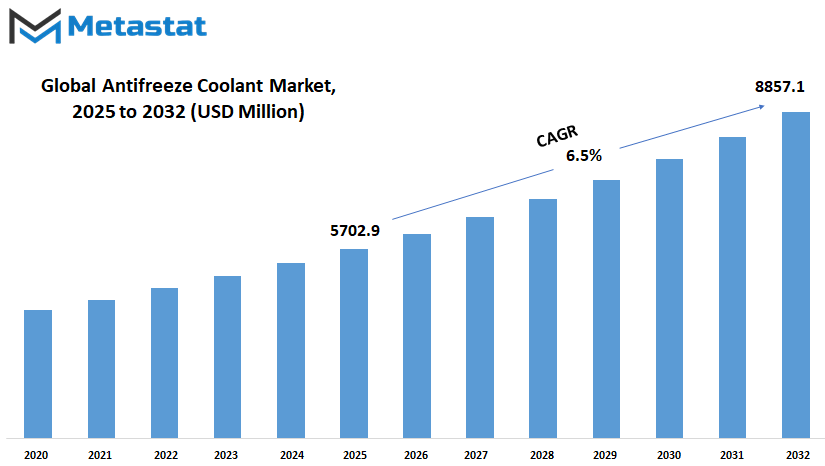
GROWTH FACTORS
The global antifreeze coolant market will experience consistent growth over the next few years, highly dependent on an array of developments occurring in various sectors. One of the strongest drivers of growth within this market is likely to be growth in vehicle production. As more and more vehicles are manufactured to fulfill growing demand, there has been an increasing requirement for effective engine cooling solutions as well. On top of that, stricter emissions requirements and broader understanding of engine performance are encouraging consumers and producers alike to look to products which are both protective and efficient. Antifreeze coolant is a fundamental ingredient in keeping engines at their optimal operating temperatures and protecting them from damage due to too much heat or cold.
The other reason for growing global antifreeze coolant market size is the increasing consciousness for regular car maintenance. People are becoming more conscious of keeping their cars in proper condition for long-term use. This shift in attitude increases the ongoing demand for coolants. Additionally, growth in construction equipment, mining machinery, and agricultural machinery is also contributing to growing use of coolants aside from passenger vehicles. The industrial use of such products will probably propel the market forward, especially as machines continue to advance and are more sensitive to temperature swings.
There are certain problems, though, that may slow the growth of the global antifreeze coolant market. Electric motors don't require the traditional engine cooling systems that gasoline or diesel motors do. If the usage of electric vehicles keeps increasing at a rapid pace, it would potentially curtail the need for conventional antifreeze coolant. Awareness regarding certain chemical ingredients used in these products would be an issue for certain businesses as well. With even more pressure from environmental organizations and government agencies, companies might have to re-engineer their products, thereby elevating production costs.
In spite of this, there are numerous opportunities that will open up new channels for the global antifreeze coolant market. Technological advancements in the design of eco-friendly coolants will appeal to both manufacturers and customers who are sustainability-conscious. Furthermore, the emerging economies will experience the demand for coolants driven by urbanization and vehicle ownership growth. Such developments will impact the way companies reshape product offerings and strategies. In the future, the global antifreeze coolant market will keep moving ahead as industries adapt to other conditions. Awareness, innovation, and local growth will drive it to expand even more in the future.
MARKET SEGMENTATION
By Type
The global antifreeze coolant market will have a progressively significant role to play in aiding vehicle performance and engine health as technology evolves. The need for effective and durable coolant solutions is increasing consistently, particularly with engines being made more compact but powerful. With growing environmental consciousness and tightening emission norms, manufacturers are being compelled to produce coolants that not only work effectively but are also ecologically sound. This change is paving the way for transformation in the production and utilization of coolants.
Coolants based on IAT, OAT, HOAT, and other technologies are one of the key segments in this market. These coolants are formulated to meet various vehicle requirements and engine types. IAT-based antifreeze, for example, will continue to be employed in older car models that need conventional formulations. OAT coolants, which are more appropriate for new engines because they last longer and provide better protection against corrosion, will gain greater usage. HOAT coolants will continue to be the first choice among drivers and manufacturers who desire a mixture of conventional and new features. These differences provide users with the correct solution to their particular requirements.
In the future, attention will be paid to optimizing performance without undermining safety or environmental quality. The growing population of electric vehicles, though less dependent on engine cooling than their combustion-engine counterparts, still necessitate sophisticated thermal management systems. This will translate into new coolant solutions designed specifically for batteries and electronics. Therefore, the global antifreeze coolant market will not only cater to conventional cars but will also increase to accommodate the needs of new car technologies.
By 2025, estimates indicate that IAT-based coolant will be worth USD 849.3 million, OAT-based coolant USD 3143.9 million, HOAT-based coolant USD 1402.1 million, and other types USD 307.6 million. These statistics indicate where the global antifreeze coolant market is moving, and here OAT takes the biggest lead. This is both consumer demand and industry momentum towards solutions that offer longevity and less maintenance.
In total, the global antifreeze coolant market is headed towards a future where innovation, environmental considerations, and performance come hand in hand. As cars become more sophisticated, the coolant for them must keep up, providing engines with an efficient and safe operation no matter what the conditions are.
By Product
The global antifreeze coolant market will experience radical changes in the near future. With the world still focusing on sustainability and long-term car performance, there will be a steady rise in demand for effective antifreeze coolants. The liquid, which is applied to maintain the engine at the appropriate temperature to prevent overheating or freezing, is now considered not only a maintenance product but also a key element in energy efficiency and caring for the environment.
In regards to the types of products that are used in this market, there are a couple of big players. Ethylene Glycol has been one of the most common ingredients due to its great performance in cold weather and hot weather. However because it is toxic, there has been a steady but evident trend away from it towards alternatives. Propylene Glycol is generally regarded as safer, especially in applications where greater human or animal exposure occurs. Glycerin, while not yet as common, is beginning to gain more attention because of its biodegradability. It can become the more fashionable alternative in the future as regulations continue to tighten and industries seek alternatives that are less harmful to the environment. Other items are also being developed, some of which offer good performance and environmental compatibility. Future improvements in engine and energy systems technology will likely influence the types of antifreeze coolants needed.
As more electric cars become commonplace, the traditional role of antifreeze will shift somewhat but not disappear. Battery packs also require thermal control, and newer coolant mixtures are already being experimented with for this. The global antifreeze coolant market itself will have to adapt not only to engine technology developments but also to the rising environmental standards set by governments and institutions worldwide. Consumer preferences are also set to play a greater part in shaping this market. Consumers are becoming more aware of what products contain and are beginning to desire products that work and are less detrimental to the environment. They will likely pressure manufacturers to do more research and make products that are able to meet these higher demands.
Overall, the global antifreeze coolant market is on a path that strikes a balance between performance, safety, and sustainability. The future of the industry depends on its ability to keep up with changing technologies, environmental demands, and consumer needs, making it one to watch closely.
By Application
The global antifreeze coolant market is likely to experience change driven by expanding demand, evolving technology, and rising awareness of engine upkeep. This market will be driven by how vehicle, machinery, and aircraft systems keep evolving. As engine protection and better temperature control continue to become necessities, the application of antifreeze coolant is likely to become increasingly vital in various fields of use. With increasing technology, coolants will have to work better under harsh conditions, last longer, and support sustainability objectives.
Based on application, the global antifreeze coolant market is segmented into automobile, industrial, aerospace, and others. The automobile application will continue to be one of the significant contributors since cars require efficient cooling systems in order to perform and not suffer from harsh weather. Newer engines operate hotter than their predecessors, and they are also smaller in size, making the job of coolant even more important. Hybrid and electric cars, though functionally distinct from each other, also depend on temperature regulation systems incorporating antifreeze coolants to dissipate heat from batteries. This indicates the market will not disappear with increased electric transport; instead, it will evolve and grow to accommodate those shifts.
The industrial sector will also experience significant growth. Factories, heavy machinery, and production units all require systems that operate round the clock under high heat and pressure. Coolants are crucial to avoid breakdowns and smooth operation. With industries becoming more modernized, there will be a stronger emphasis on applying sophisticated coolants that last longer, minimize downtime, and are less maintenance-intensive. This reduces expenses as well as helps to keep unnecessary environmental wastage at bay.
In the aerospace industry, coolants are applied in systems where temperature management is an issue of performance and safety. Aircraft experience extreme temperature fluctuations and are under high stress. Application of specialized antifreeze coolants will persist, particularly with an increase in aircraft being designed using advanced materials and design. Other applications including marine engines, agricultural equipment, and stationary generators also require coolants to function reliably. Each of these uses will have its own requirements, and the global antifreeze coolant market will react in turn by producing products that meet those requirements.
In the future, the global antifreeze coolant market will not only expand in terms of size, but will also evolve in terms of focus toward innovation, efficiency, and sustainability. It will develop in tandem with world trends in transportation, energy, and technology.
|
Forecast Period |
2025-2032 |
|
Market Size in 2025 |
$5702.9 million |
|
Market Size by 2032 |
$8857.1 Million |
|
Growth Rate from 2025 to 2032 |
6.5% |
|
Base Year |
2024 |
|
Regions Covered |
North America, Europe, Asia-Pacific Green, South America, Middle East & Africa |
REGIONAL ANALYSIS
The global antifreeze coolant market is influenced by different regional factors, and each region affects demand and supply differently. With increasing demand for effective vehicle performance and temperature management, particularly with fluctuating weather conditions and industrialization, these factors will rise significantly across the regions. North America, comprising the U.S., Canada, and Mexico, is expected to remain at the forefront of the market in terms of innovation and adoption of sophisticated coolants. The robust presence of automotive industries, coupled with customer penchant for high-performance cars, will sustain the consistent demand for antifreeze coolant products in this region.
Within Europe, with nations such as the UK, Germany, France, and Italy having a substantial contribution, environmental laws will prompt cleaner and more efficient coolant solutions. The sustainability trend within this region will probably inspire producers to create environmentally friendly versions of antifreeze coolant, which will determine future development. Advances in technology and consumer knowledge about auto care will also stimulate more stable demand within Europe.
Asia-Pacific, which includes nations like India, China, Japan, and South Korea, will experience high growth. With the fast-paced growth in automobile production and sales in this region, the demand for antifreeze coolant will grow gradually. As the infrastructure and transport systems keep developing, particularly in emerging regions, more vehicles will need long-lasting and effective coolant systems. This will most probably attract both domestic and foreign players in the market, and the Asia-Pacific region would become a competitive and vibrant region for producing and selling antifreeze coolants.
In South America, such as Brazil and Argentina, the expansion of the automotive business will affect demand for coolants. Though this region is likely to expand at a slower rate than Asia-Pacific, increased economic stability and investment in industrial sectors will create new opportunities. The Middle East & Africa region, covering the GCC Countries, Egypt, and South Africa, will also witness increasing demand. With the increase in the application of commercial vehicles and equipment in industries such as construction and mining, antifreeze coolant will become an essential part of machine maintenance.
In the future, the global antifreeze coolant market will change according to climatic trends, industrial requirements, and advancing vehicle technologies. As technology progresses and environmental concerns grow, the market will expand not only in terms of size but also in quality and efficacy in all geographically dispersed areas.
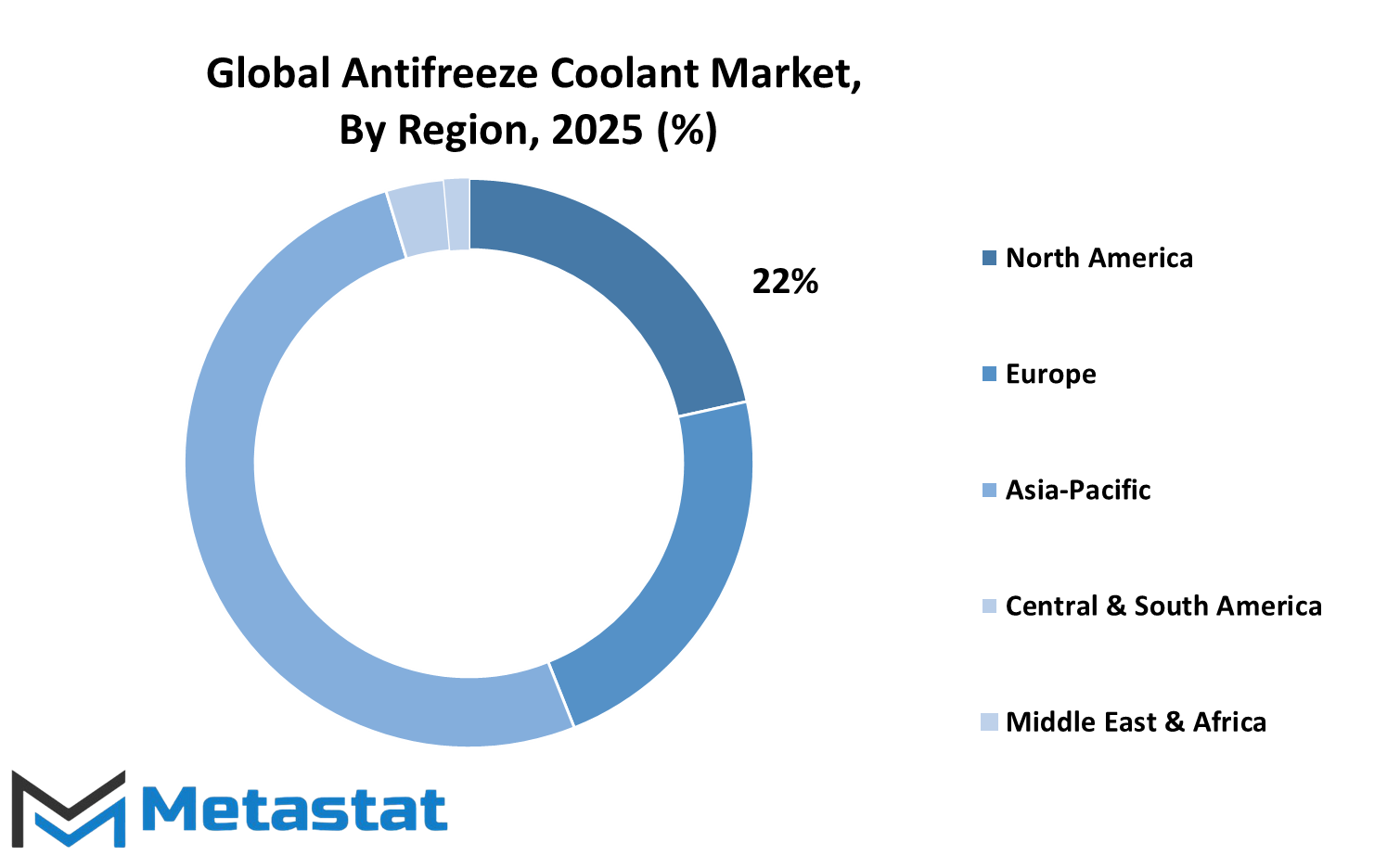
COMPETITIVE PLAYERS
The global antifreeze coolant market will keep expanding steadily as increased focus is put on vehicle maintenance, engine efficiency, and protecting the environment. With the volume of vehicles continuing to grow, and with growing awareness about the maintenance of engines, the global antifreeze coolant market can only expand. These fluids are used to keep engines from overheating and from freezing, hence they are a year-round need. In colder climates, they keep internal freezing from damaging engines seriously, while in warmer climates, they maintain temperature and ensure engines operate efficiently.
Going forward, evolving automotive technology and environmental policies will influence the manner in which antifreeze coolant products are formulated and utilized. For instance, as electric and hybrid cars gain popularity, the market will require uniquely formulated coolant fluids that are suitable for their varying system needs. Electric cars generate less heat than internal combustion engines, yet they still have a need for cooling systems to maintain battery temperature. This change will challenge manufacturers to think outside of conventional formulation and come up with products that address new standards in safety, longevity, and energy conservation.
Several major players in the global antifreeze coolant market such as BASF SE, ExxonMobil Corporation, Shell plc, Chevron Corporation, and Valvoline Inc. are already making investments in research to develop products that are not only better for engines but also for the environment. Bio-based and low-toxicity coolants will become more popular as individuals become more environmentally aware. These newer technologies are being engineered to minimize damage to ecosystems in the event of a spill or in disposing of the fluids. The life of coolants is also being extended, which will cut down on replacement needs and lower the environmental footprint.
Firms like Penrite Oil Co Pty Ltd, TotalEnergies SE, Repsol S.A., and FUCHS Group are also creating sophisticated coolants to keep pace with the development of future engine designs. In a world where the global transportation sector is shifting toward fuel efficiency and longer lifecycles of the vehicle, the global antifreeze coolant market will evolve both in composition and packaging. Protection and temperature control will not be the only concerns but also compatibility with multiple engine materials.
As more nations tighten emissions regulations and foster cleaner technology, antifreeze coolant manufacturers must shift gears fast. Through alliances, new product introductions, or more efficient distribution, the global antifreeze coolant market will remain busy, adaptable, and responsive to changing demand.
Antifreeze Coolant Market Key Segments:
By Type
- IAT (Inorganic Acid Technology)
- OAT (Organic Acid Technology)
- HOAT (Hybrid Organic Acid Technology)
- Others
By Product
- Ethylene Glycol
- Propylene Glycol
- Glycerin
- Others
By Application
- Automobile
- Industrial
- Aerospace
- Others
Key Global Antifreeze Coolant Industry Players
- BASF SE
- ExxonMobil Corporation
- Shell plc
- Chevron Corporation
- Valvoline Inc.
- Penrite Oil Co Pty Ltd
- Old World Industries, LLC
- Recochem Inc.
- TotalEnergies SE
- BP p.l.c.
- Sinopec Lubricant Company
- Petroliam Nasional Berhad (PETRONAS)
- ENEOS Corporation
- Gulf Oil International Group
- Motul
- Moove Lubricants Limited. (Comma Oil & Chemicals Ltd.)
- Repsol S.A.
- Warren Oil Company
- FUCHS Group
- Amsoil Inc.
WHAT REPORT PROVIDES
- Full in-depth analysis of the parent Industry
- Important changes in market and its dynamics
- Segmentation details of the market
- Former, on-going, and projected market analysis in terms of volume and value
- Assessment of niche industry developments
- Market share analysis
- Key strategies of major players
- Emerging segments and regional growth potential



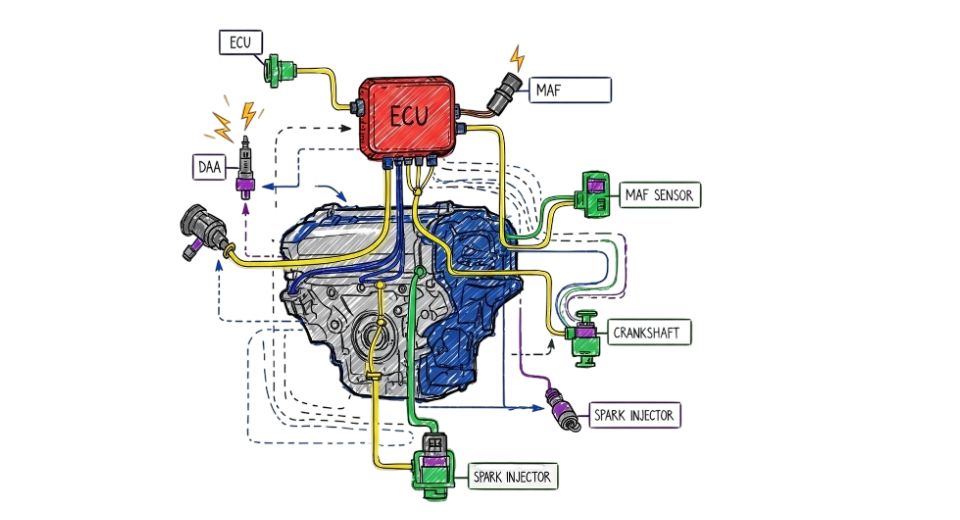
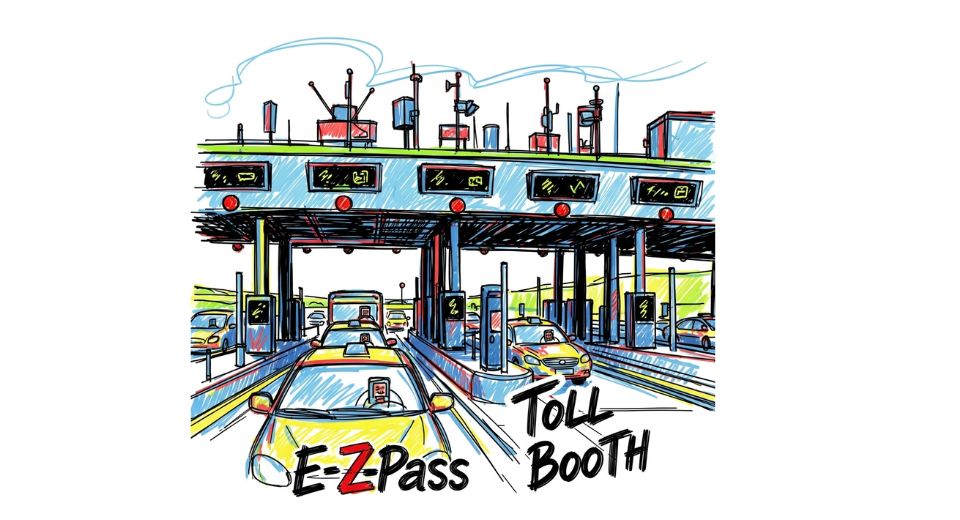

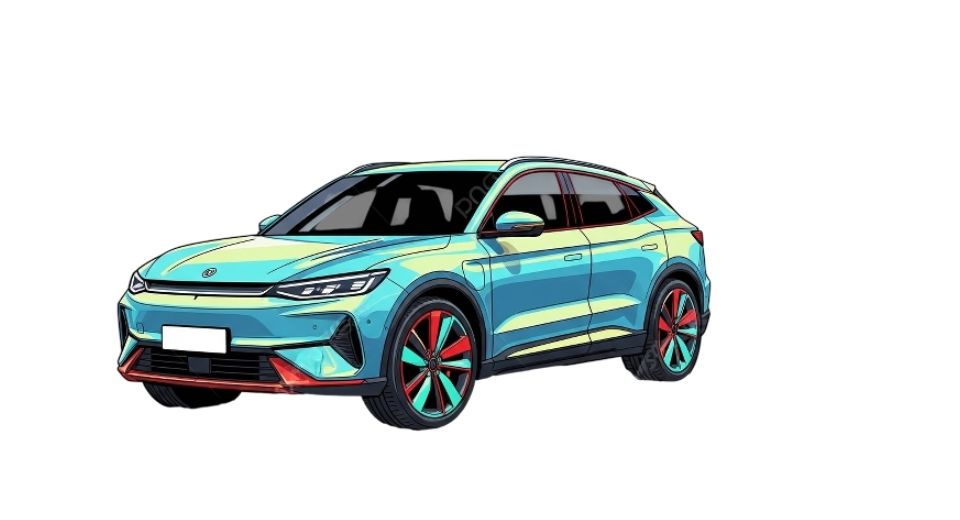




 US: +1 3023308252
US: +1 3023308252






